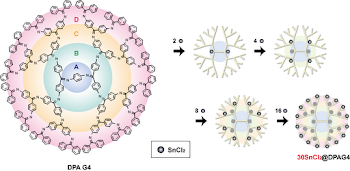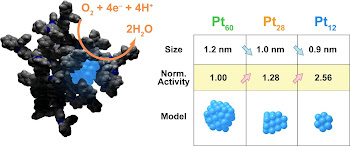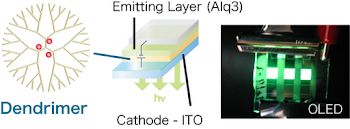Highlight of the research
 A series of novel dendrimers composed of dendritic phenylazomethines (DPAs) were synthesized with several types of functional cores in our group. The metal coordination to the DPAs is stepwise by the layers, therefore, they can be used as a scaffold for the precise hybridization between metal ions and organic macromolecules. Because of uniform structure of the dendrimer, there is no structural dispersion in the macromolecule-metal hybrid of the DPAs. Also, the number of metal ions loaded in one dendrimer should have no statistical distribution in principle due to the precise metal assembling. Utilizing this outstanding characteristic, we are now developping these materials for several applications, which would contribute the next generation energy technology, chemical conversion and electronics.
A series of novel dendrimers composed of dendritic phenylazomethines (DPAs) were synthesized with several types of functional cores in our group. The metal coordination to the DPAs is stepwise by the layers, therefore, they can be used as a scaffold for the precise hybridization between metal ions and organic macromolecules. Because of uniform structure of the dendrimer, there is no structural dispersion in the macromolecule-metal hybrid of the DPAs. Also, the number of metal ions loaded in one dendrimer should have no statistical distribution in principle due to the precise metal assembling. Utilizing this outstanding characteristic, we are now developping these materials for several applications, which would contribute the next generation energy technology, chemical conversion and electronics.
Subnanometre metal/metaloxide clusters without size distribution
 Fine control of the number of metal sources in one discrete molecular cupsule allows us to synthesize metal subnanometre particles (clusters) without any size distribution. We have found several "hidden" properties of these metal clusters. For example, we elucidated that ultra-small platinum particles exhibited exceptionally high catalytic activity in oxygen reduction reaction (ORR) against the conventional knowledge. We also succeeded the synthesis of titania (TiO2) nanodots, of which size is smaller than 1 nm, exhibiting the "quantum size effect" for the first time.
Fine control of the number of metal sources in one discrete molecular cupsule allows us to synthesize metal subnanometre particles (clusters) without any size distribution. We have found several "hidden" properties of these metal clusters. For example, we elucidated that ultra-small platinum particles exhibited exceptionally high catalytic activity in oxygen reduction reaction (ORR) against the conventional knowledge. We also succeeded the synthesis of titania (TiO2) nanodots, of which size is smaller than 1 nm, exhibiting the "quantum size effect" for the first time.
Application for electronics devices
 Development of this property without any reduction in solubility in organic media enabled the easy preparation of homogeneous amorphous films in which the metal and macromolecule are precisely hybridized. As a result, the thin solid of the metal assembling dendrimer acts as an excellent organic semiconductor in the hole-transport layer of a light-emitting diode.
Development of this property without any reduction in solubility in organic media enabled the easy preparation of homogeneous amorphous films in which the metal and macromolecule are precisely hybridized. As a result, the thin solid of the metal assembling dendrimer acts as an excellent organic semiconductor in the hole-transport layer of a light-emitting diode.
